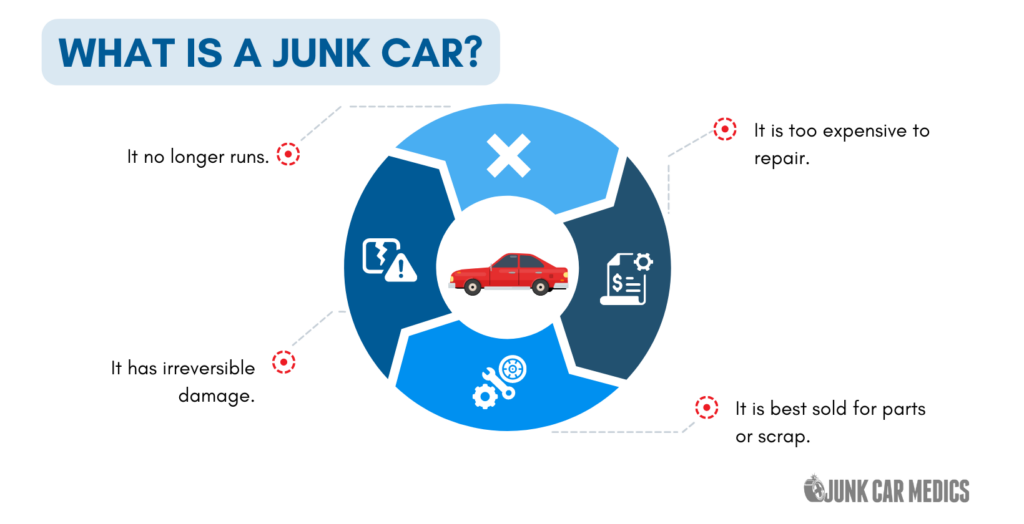What is a Junk Car?
A junk car is a vehicle that no longer holds value as transportation and is typically sold for its parts or scrap metal.
We define junk cars as vehicles that are too damaged, too old, or too expensive to fix. Most can't pass inspections, don't start or drive, or aren't worth the cost of repairs. But while junk cars are no longer useful on the road, they still carry value in recyclable materials and salvageable parts.

Other Names for a Junk Car
People use different terms to describe junk cars. Some highlight condition, others legal status or resale value.
You might hear:
- Scrap car: Sold for metal, not use
- Clunker / beater / jalopy / hooptie: Still runs but barely
- Salvage vehicle: Declared a total loss by insurance
- End-of-life vehicle (ELV): Industry term for cars at the end of their lifecycle
- Non-running vehicle: Doesn’t start or move
- Junker: Total loss, usually towed away
These all point to the same thing: a vehicle that’s reached the end of the road.
What Makes a Car a Junk Car?
Most junk cars share one or more of these traits:
- Mechanical problems: Blown engine, failed transmission, constant overheating
- Severe damage: From accidents, fire, or floods
- No title or registration: Legal issues make it hard to sell
- High mileage: 150,000 to 300,000+ miles
- Age-related wear: Rust, frame damage, or outdated safety features
- Emissions or safety failure: Can’t pass inspection, unsafe to drive
Driveable vs. Undriveable Junk Cars
Some junk cars still move, but that doesn’t mean they’re roadworthy.
Undriveable:
- Won’t start or stay running
- Unsafe brakes, steering, or electrical systems
- Requires towing
- Worth less due to fewer usable parts
Driveable:
- Can still start and move under their own power
- May fail emissions or have major warning lights
- Often worth more because parts can be reused
- Still considered junk — just not yet completely broken
About 65% of junk cars are undriveable. The other 35% still limp along, but not for long.
How Old Are Junk Cars?
Most junk cars are around 18 years old when they hit the end of the road.
We regularly see:
- Model years 2000–2009 dominate the junkyard
- Luxury cars lasting 20+ years before junking
- Economy cars junked sooner (15–17 years)
- Commercial vehicles pushed to higher mileage before disposal
Durability has improved over time, but every vehicle hits a point where repairs no longer make sense.
How Many Miles Do Junk Cars Usually Have?
Mileage is a major indicator of vehicle wear.
Typical junk cars we buy show:
- 150,000–300,000 miles on the odometer
- Diesels lasting longer, sometimes over 300,000
- Low-mileage junk cars caused by collisions or mechanical failure
High mileage often means:
- Worn-out engines and transmissions
- Sagging suspension and rusted frames
- Frequent, costly repairs
Why Junk Cars Are Still Valuable
Even if a car doesn’t run, it can be recycled.
We recycle junk cars by:
- Removing and reselling usable parts
- Crushing and shredding the frame for scrap metal
- Draining and disposing of fluids safely
- Meeting environmental disposal laws
Selling your junk car puts money in your pocket and helps the environment by reducing waste and promoting metal reuse. Want more detail? See how much junk cars are worth, with real examples, value factors, and tips to get the most cash.
What Should You Do With a Junk Car?
You have options. Not all junk cars need to be scrapped immediately.
Ways to get rid of a junk car:
- Sell it to a licensed junk car buyer (like us)
- Scrap it for metal at a local yard
- Donate it for a tax deduction
- Part it out yourself
- Try selling to a dealer (rare)
Explore all your options → What To Do With a Junk Car
Learn how to sell → How to Sell a Junk Car
How Junk Car Medics Helps
We make it easy to get rid of your junk car — and get paid.
- You get a free, instant offer
- We schedule free towing, often same-day
- You get paid on the spot
- We handle the paperwork and title transfer
- No hidden fees, no scams, no stress
We’ve helped over 200,000 people sell their junk cars. Let us help you too.
Ready to Sell Your Junk Car?
Get a fast, no-obligation quote today to get cash for junk cars. We’ll tow it for free and hand you cash on the spot — no waiting, no haggling.
